Combing High-Modulus Fibers with a Novel Foaming Structure Applied to Protective Sandwich-Structured Composites: Manufacturing Techniques and Property Evaluations
Abstract
1. Introduction
2. Experimental
2.1. Materials
2.2. Preparation Process of PU Foam Composites
2.3. Measurements
2.3.1. Drop Weight Impact Test
2.3.2. Drop Weight Puncture Resistance Test
2.3.3. Vertical Rebound Elasticity Measurement
2.3.4. Electromagnetic Wave Shielding Effectiveness (EMSE) Measurement
3. Results
3.1. Surface Observation of PU Foam Composites
3.2. Mechanical Performances of PU Foam Composites
3.3. Electromagnetic Wave Shielding Effectiveness (EMSE)
4. Discussion
5. Conclusions
Author Contributions
Funding
Institutional Review Board Statement
Informed Consent Statement
Data Availability Statement
Acknowledgments
Conflicts of Interest
References
- Carruth, M.A.; Allwood, J.M.; Moynihan, M.C. The technical potential for reducing metal requirements through lightweight product design. Resour. Conserv. Recycl. 2011, 57, 48–60. [Google Scholar] [CrossRef]
- Zhu, C.-Y.; Yu, G.-L.; Ren, X.; Huang, B.-h.; Gong, L. Modelling of the effective thermal conductivity of composites reinforced with fibers and particles by two-step homogenization method. Compos. Sci. Technol. 2022, 230, 109766. [Google Scholar] [CrossRef]
- Shukla, U.; Garg, K. Journey of smart material from composite to shape memory alloy (SMA), characterization and their applications—A review. Smart Mater. Med. 2023, 4, 227–242. [Google Scholar] [CrossRef]
- Zhang, J.; Ma, M.; Bi, Y.; Liao, Z.; Ma, Y.; Huang, W.; Lyu, P.; Feng, C. A review of epoxy-based composite materials: Synthesis, structure and application for electromagnetic wave absorption. J. Alloys Compd. 2022, 922, 166096. [Google Scholar] [CrossRef]
- Ibrahim, I.D.; Jamiru, T.; Sadiku, E.R.; Kupolati, W.K.; Mpofu, K.; Eze, A.A.; Uwa, C.A. Production and Application of Advanced Composite Materials in Rail Cars Development: Prospect in South African Industry. Procedia Manuf. 2019, 35, 471–476. [Google Scholar] [CrossRef]
- Das, R.; Bhattacharjee, C. Chapter 4—Green composites, the next-generation sustainable composite materials: Specific features and applications. In Green Sustainable Process for Chemical and Environmental Engineering and Science; Altalhi, T., Inamuddin, Eds.; Elsevier: Amsterdam, The Netherlands, 2022; pp. 55–70. [Google Scholar]
- Xu, X.; Wang, G.; Yan, H.; Yao, X. Constitutive relationship of fabric rubber composites and its application. Compos. Struct. 2023, 304, 116302. [Google Scholar] [CrossRef]
- Xu, J.; Ma, J.; Peng, Y.; Cao, S.; Zhang, S.; Pang, H. Applications of metal nanoparticles/metal-organic frameworks composites in sensing field. Chin. Chem. Lett. 2022; in press. [Google Scholar] [CrossRef]
- Yang, X.; Chen, Y.; Zhang, C.; Duan, G.; Jiang, S. Electrospun carbon nanofibers and their reinforced composites: Preparation, modification, applications, and perspectives. Compos. Part B Eng. 2023, 249, 110386. [Google Scholar] [CrossRef]
- Pham, H.H.; Dinh, N.H.; Kim, S.-H.; Park, S.-H.; Choi, K.-K. Tensile behavioral characteristics of lightweight carbon textile-reinforced cementitious composites. J. Build. Eng. 2022, 57, 104848. [Google Scholar] [CrossRef]
- Wang, B.; Qi, Z.; Chen, X.; Sun, C.; Yao, W.; Zheng, H.; Liu, M.; Li, W.; Qin, A.; Tan, H.; et al. Preparation and mechanism of lightweight wood fiber/poly(lactic acid) composites. Int. J. Biol. Macromol. 2022, 217, 792–802. [Google Scholar] [CrossRef]
- Gómez-Fernández, S.; Günther, M.; Schartel, B.; Corcuera, M.A.; Eceiza, A. Impact of the combined use of layered double hydroxides, lignin and phosphorous polyol on the fire behavior of flexible polyurethane foams. Ind. Crops Prod. 2018, 125, 346–359. [Google Scholar] [CrossRef]
- Harith, I.K. Study on polyurethane foamed concrete for use in structural applications. Case Stud. Constr. Mat. 2018, 8, 79–86. [Google Scholar] [CrossRef]
- Santiago-Calvo, M.; Tirado-Mediavilla, J.; Rauhe, J.C.; Jensen, L.R.; Ruiz-Herrero, J.L.; Villafañe, F.; Rodríguez-Pérez, M.Á. Evaluation of the thermal conductivity and mechanical properties of water blown polyurethane rigid foams reinforced with carbon nanofibers. Eur. Polym. J. 2018, 108, 98–106. [Google Scholar] [CrossRef]
- Moon, J.; Kwak, S.B.; Lee, J.Y.; Kim, D.; Ha, J.U.; Oh, J.S. Synthesis of polyurethane foam from ultrasonically decrosslinked automotive seat cushions. Waste Manag. 2019, 85, 557–562. [Google Scholar] [CrossRef]
- Jonjaroen, V.; Ummartyotin, S.; Chittapun, S. Algal cellulose as a reinforcement in rigid polyurethane foam. Algal Res. 2020, 51, 102057. [Google Scholar] [CrossRef]
- Sivakumar, S.; Navin Kumar, B. Enhancement of bending strength of polyurethane foam reinforced with basalt fiber with silica nanoparticles in comparison with plain polyurethane foam. Mater. Today Proc. 2022; in press. [Google Scholar] [CrossRef]
- Chen, S.; Jiang, Y. The acoustic property study of polyurethane foam with addition of bamboo leaves particles. Polym. Compos. 2018, 39, 1370–1381. [Google Scholar] [CrossRef]
- Stanzione, M.; Russo, V.; Oliviero, M.; Verdolotti, L.; Sorrentino, A.; Di Serio, M.; Tesser, R.; Iannace, S.; Lavorgna, M. Synthesis and characterization of sustainable polyurethane foams based on polyhydroxyls with different terminal groups. Polymer 2018, 149, 134–145. [Google Scholar] [CrossRef]
- Mohammadi, B.; Safaiyan, A.; Habibi, P.; Moradi, G. Evaluation of the acoustic performance of polyurethane foams embedded with rock wool fibers at low-frequency range; design and construction. Appl. Acoust. 2021, 182, 108223. [Google Scholar] [CrossRef]
- Zhang, L.; Yilmaz, E.D.; Schjødt-Thomsen, J.; Rauhe, J.C.; Pyrz, R. MWNT reinforced polyurethane foam: Processing, characterization and modelling of mechanical properties. Compos. Sci. Technol. 2011, 71, 877–884. [Google Scholar] [CrossRef]
- Saha, M.C.; Kabir, M.E.; Jeelani, S. Enhancement in thermal and mechanical properties of polyurethane foam infused with nanoparticles. Mater. Sci. Eng. A 2008, 479, 213–222. [Google Scholar] [CrossRef]
- Kumar, M.; Kaur, R. Glass fiber reinforced rigid polyurethane foam: Synthesis and characterization. e-Polymers 2017, 17, 517–521. [Google Scholar] [CrossRef]
- Wang, H.; Li, T.-T.; Ren, H.; Peng, H.; Huang, S.-Y.; Lin, Q.; Lin, J.-H.; Lou, C.-W. Expanded Vermiculite-Filled Polyurethane Foam-Core Bionic Composites: Preparation and Thermal, Compression, and Dynamic Cushion Properties. Polymers 2019, 11, 1028. [Google Scholar] [CrossRef]
- Zhai, W.; Yu, J.; Wu, L.; Ma, W.; He, J. Heterogeneous nucleation uniformizing cell size distribution in microcellular nanocomposites foams. Polymer 2006, 47, 7580–7589. [Google Scholar] [CrossRef]
- Sachse, S.; Poruri, M.; Silva, F.; Michalowski, S.; Pielichowski, K.; Njuguna, J. Effect of nanofillers on low energy impact performance of sandwich structures with nanoreinforced polyurethane foam cores. J. Sandw. Struct. Mater. 2014, 16, 173–194. [Google Scholar] [CrossRef]
- Metın, D.; Tihminlioğlu, F.; Balköse, D.; Ülkü, S. The effect of interfacial interactions on the mechanical properties of polypropylene/natural zeolite composites. Compos. Part A Appl. Sci. Manuf. 2004, 35, 23–32. [Google Scholar] [CrossRef]
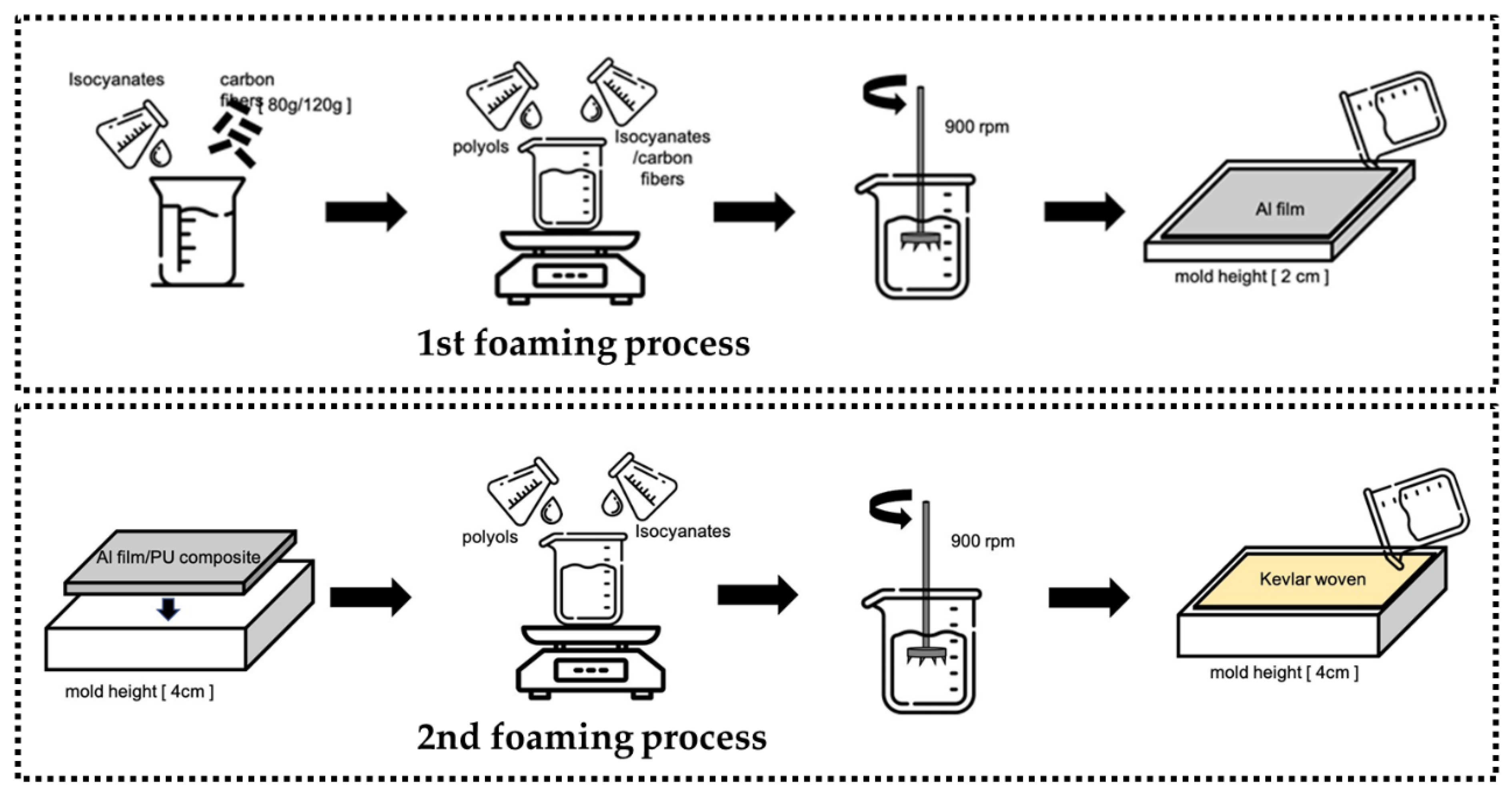
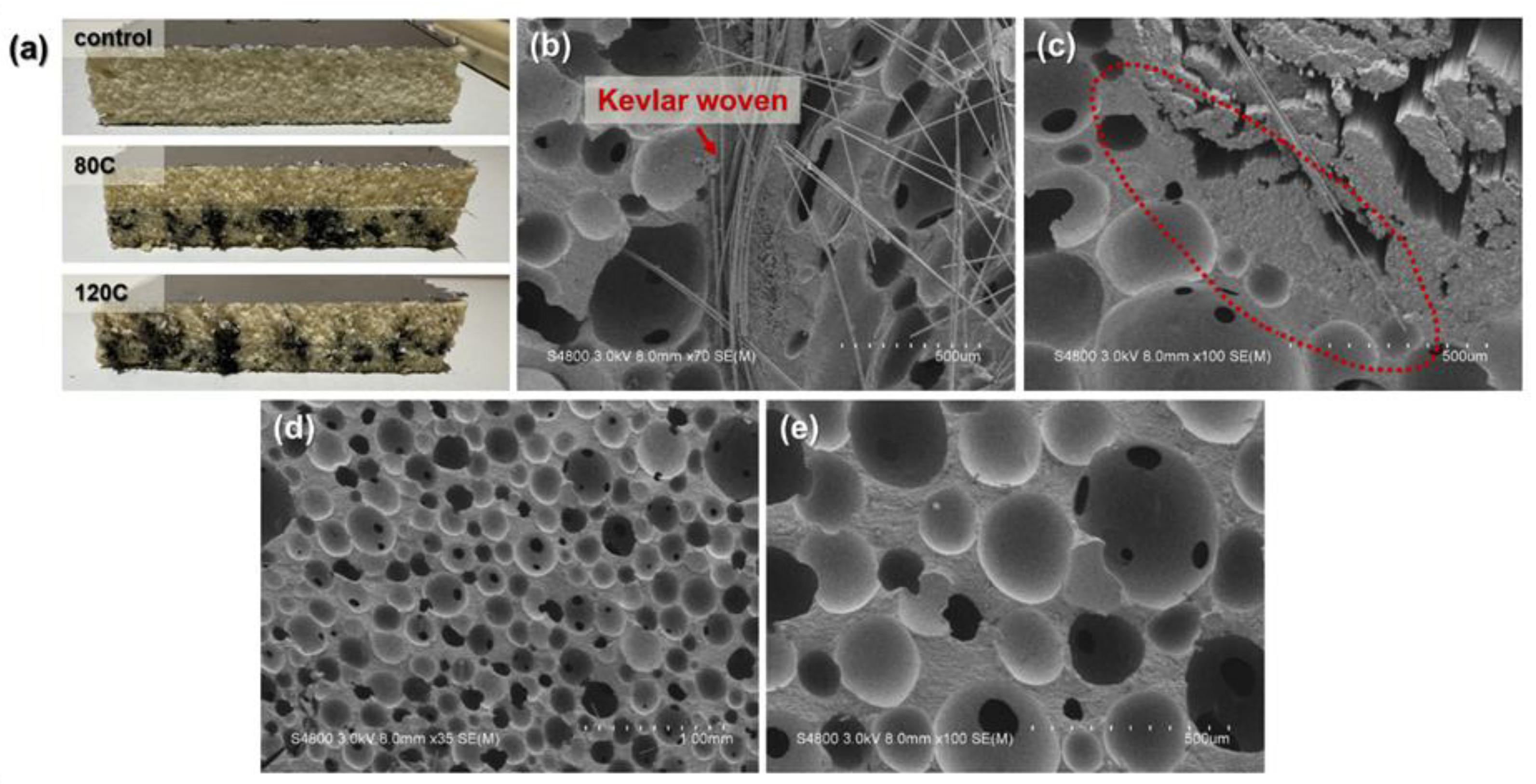

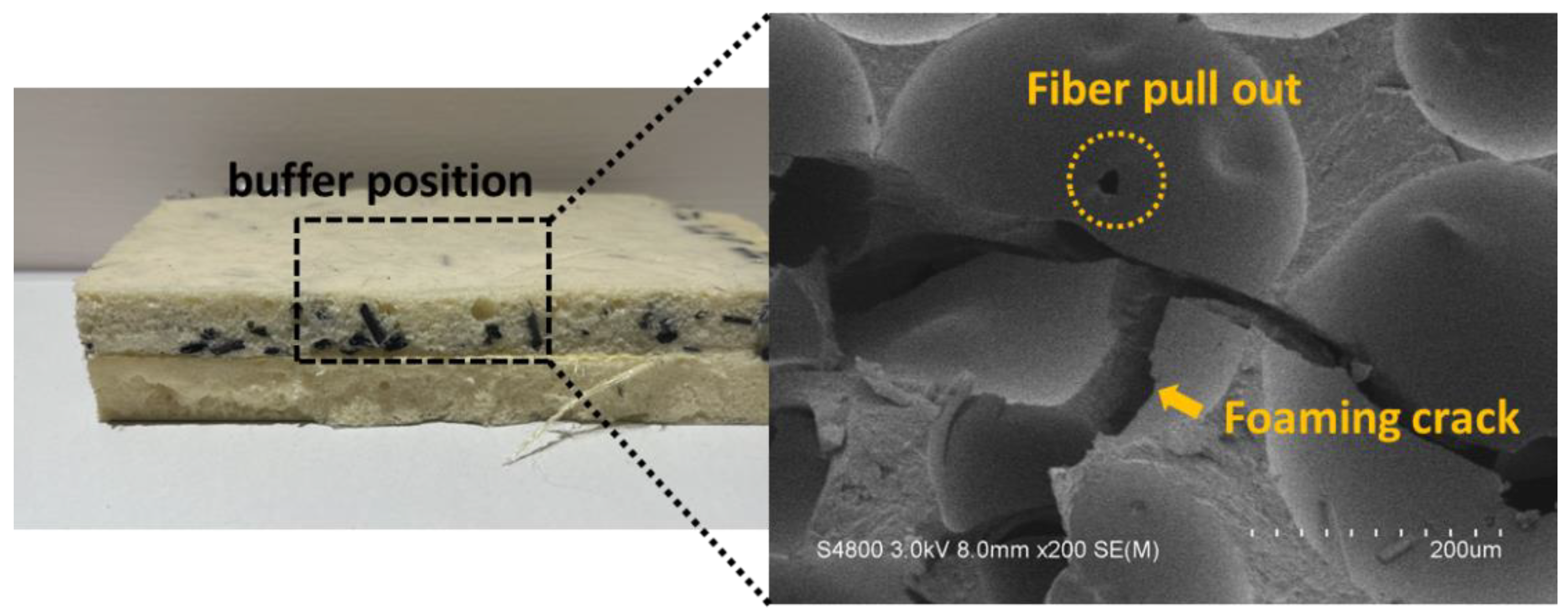
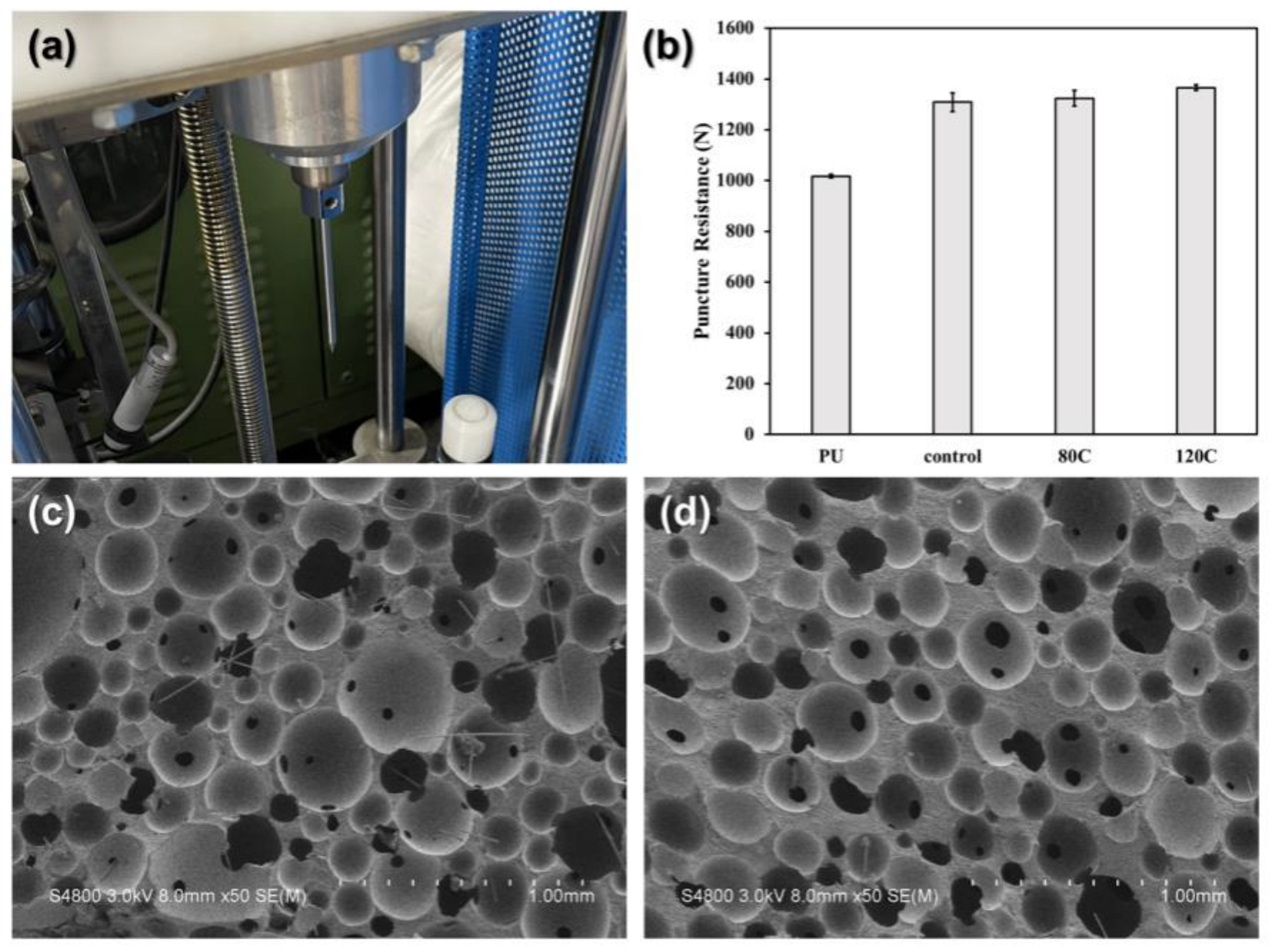

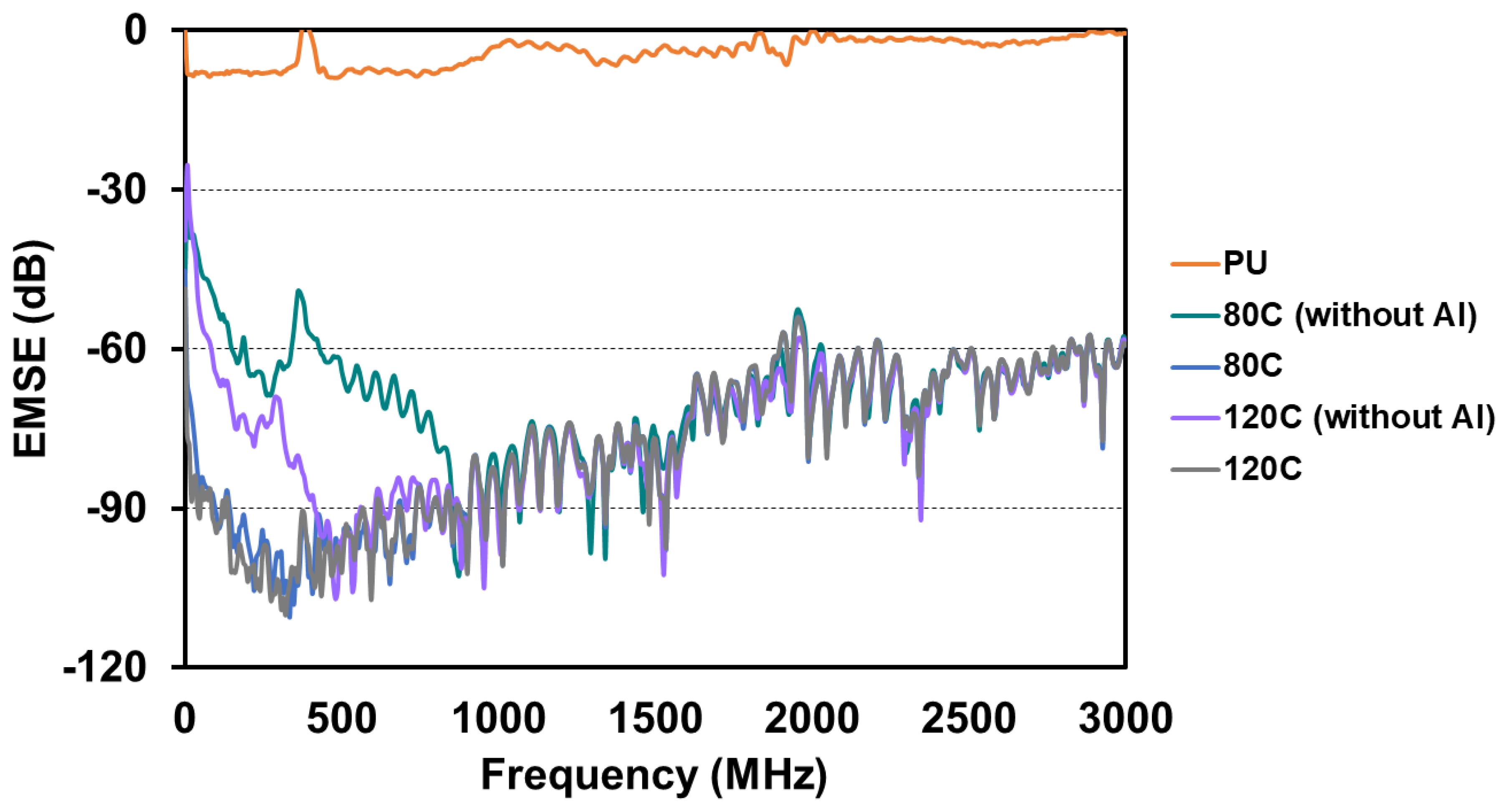
| Sample Types | Kevlar Woven Fabric (K) | Carbon Fiber (C) | Al Film (A) | Constituent Layers |
|---|---|---|---|---|
| PU | − | − | − | PU |
| Control | − | − | + | A/PU/K/PU/A |
| 80C | + | 80 g | + | A/PU + C (80 g)/K/PU/A |
| 120C | + | 120 g | + | A/PU + C (120 g)/K/PU/A |
Disclaimer/Publisher’s Note: The statements, opinions and data contained in all publications are solely those of the individual author(s) and contributor(s) and not of MDPI and/or the editor(s). MDPI and/or the editor(s) disclaim responsibility for any injury to people or property resulting from any ideas, methods, instructions or products referred to in the content. |
© 2023 by the authors. Licensee MDPI, Basel, Switzerland. This article is an open access article distributed under the terms and conditions of the Creative Commons Attribution (CC BY) license (https://creativecommons.org/licenses/by/4.0/).
Share and Cite
Ho, Y.-H.; Lin, Y.-Y.; Lin, M.-C.; Lou, C.-W.; Chen, Y.-S.; Lin, J.-H. Combing High-Modulus Fibers with a Novel Foaming Structure Applied to Protective Sandwich-Structured Composites: Manufacturing Techniques and Property Evaluations. Polymers 2023, 15, 424. https://doi.org/10.3390/polym15020424
Ho Y-H, Lin Y-Y, Lin M-C, Lou C-W, Chen Y-S, Lin J-H. Combing High-Modulus Fibers with a Novel Foaming Structure Applied to Protective Sandwich-Structured Composites: Manufacturing Techniques and Property Evaluations. Polymers. 2023; 15(2):424. https://doi.org/10.3390/polym15020424
Chicago/Turabian StyleHo, Yi-Huan, Yan-Yu Lin, Mei-Chen Lin, Ching-Wen Lou, Yueh-Sheng Chen, and Jia-Horng Lin. 2023. "Combing High-Modulus Fibers with a Novel Foaming Structure Applied to Protective Sandwich-Structured Composites: Manufacturing Techniques and Property Evaluations" Polymers 15, no. 2: 424. https://doi.org/10.3390/polym15020424
APA StyleHo, Y.-H., Lin, Y.-Y., Lin, M.-C., Lou, C.-W., Chen, Y.-S., & Lin, J.-H. (2023). Combing High-Modulus Fibers with a Novel Foaming Structure Applied to Protective Sandwich-Structured Composites: Manufacturing Techniques and Property Evaluations. Polymers, 15(2), 424. https://doi.org/10.3390/polym15020424









